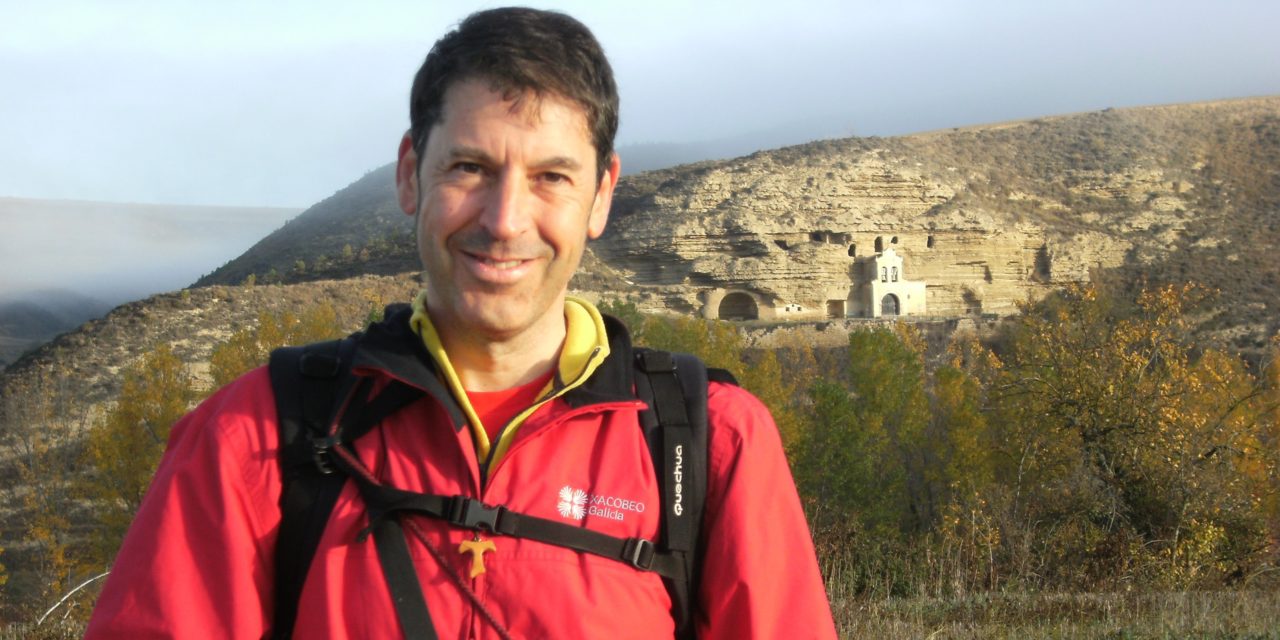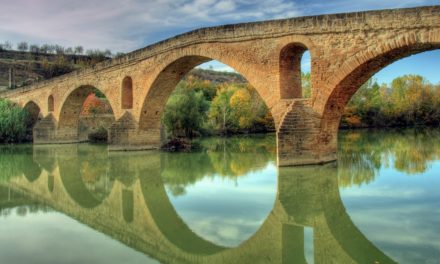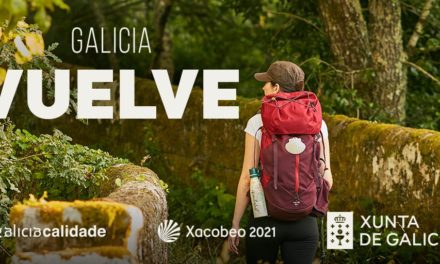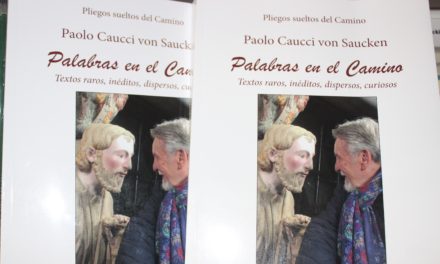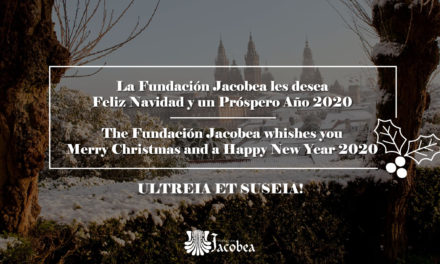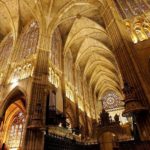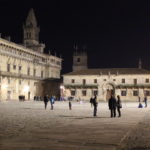Antón Pombo is a specialist on the Camino de Santiago. He is an historian and researcher -with a doctoral thesis linked to the history of Compostela- and a writer specialized on the Camino with decades of experience as an author of books, articles and guides, and also a pilgrim who has traveled and continues to travel along his different routes. Because of his training and experience Anton Pombo is a privileged observer of the present revitalization of the pilgrimages to Santiago: with not only updated knowledge of its history, and the practical and organizational aspects of the Camino, but also as a pilgrim and witness to its most human aspects. For all these reasons, we wanted to take advantage of our first meeting with him to invite him to make general reflections on the Camino de Santiago.
-I remember you were 20 years old when you entered the world of the Camino, I think I heard you talk about having painted yellow arrows on the Camino Francés with Elías Valiña … Could you tell us something about those beginnings and what you then found on the Camino?
My first contact with the Camino was around my 20th year, I think it was a countercultural bet. A group of friends who studied history decided that, instead of going on a trip to an exotic place as everyone did at that time, we wanted to go to the Camino de Santiago. We had completed the second year of our studies, studying the Camino in medieval history and art, and we thought we could do it. We did it by bike from Saint-Jean-Pied-de-Port and, yes, on that Camino, when I arrived in O Cebreiro, I met Valiña, who infected me with his insistence and enthusiasm; from then on I built a strong relationship with him, we made a pilgrimage together and it is true that on some occasion I accompanied him to paint arrows.
At that time there was nothing, no infrastructure, nothing to entice you. There was certainly the whole apparatus of history, the testimonies of the pilgrimage, temples, monasteries … It was like taking a romantic journey through an empty Spain. The inhabitants of the places we traveled through saw us as champions or precursors of what they expected to happen, and they were so warm, friendly and welcoming.
The scenario remains the same in many respects, but the rest … It is true that the spirit of welcome has changed and something has been lost, but in those days there few pilgrims. At the time I started, I traveled every year in the month of September and this was an empty month- you hardly ever saw another pilgrim.
-You continue to travel the different routes of the Camino, which gives you the position of a privileged observer. Without falling into a nostalgic view, what do you think are the main changes in the Camino for good and for bad ?, and what remains?
The most negative change is clear: overcrowding. We wanted more pilgrims, but not so many. Also the noise, there is a lot of noise and much of it is created by people who are only attracted by what is fashionable and quite bereft of the pilgrims’ spirit. There is excessive commercialization, places that charge excessive prices; which is a mistake, because word soon gets around on the networks. Also the pilgrim menus have changed, I believe that its gastronomic- nutritional quality has fallen off.
The signposting of many routes and the fact that now pilgrimages are made almost throughout the year, make it possible to counteract many of these changes, but the great problem is the coexistence of tourism with the Camino. The confusion between a tourism which must be understood to be like fast food- as rapid consumption of experiences and the authentic Way … There are two worlds that coexist in equal dimensions: one is that of consumption and the short route, and on the other hand the slower, deeper experience of those who travel long distances. In this sense there are routes that have become fantastic refuges for those who want to avoid coexistence with tourism, such as the Vía de la Plata.
But certainly there have been changes for the better. For example, as far as safety is concerned, before the Camino coincided with and crossed roads continuously, now paths and stretches of land have been recovered. In my first years as a pilgrim, accidents and abuses were common, but much time and money has been invested in the Way and today the roads are safe.
Another radical change for good is the one that has occurred in pilgrims’ shelters. Today there are services of all kinds, whereas before you had to sleep where you could, in abandoned parish houses and sometimes in the open air. There has been much improvement in this area, there are far more possibilities to choose from, and in addition much more information available. Certainly, the charm of having to ask your way has been lost, but nowadays everything is well organized, it is less romantic but safer and with many more services. There has been an improvement in all the services: information, signposting, health care…
I am nostalgic and I would not like to go back to the early 80’s. The Camino is different, but more comfortable and better organized. And, of course, there is the human factor, another very positive change, today you meet people from all over the world, exchange experiences, speak and learn languages. Last year I travelled the Camino de Arles in France, and I remembered the last time when I had spent 6 days almost alone, walking and in the shelters, that was the reality of the whole Camino in the 80’s and I did not want to relive that. In this respect, the changes that have come about have been for the good.
-I know that you are very committed to the Way, that from the Jacobean associations and diverse organisations you have been involved in the defense of many causes and denunciation of many abuses. What do you consider to be or should be the “red lines” or limits that should not be crossed on the Camino de Santiago?
I think the limits have not been crossed yet, but we must be watchful. For example, there were companies that wanted to put scooters in the stopping points of the Camino, it was proposed to create a zip line in O Cebreiro … That would be one of the trends that could lead to the degeneration of the Way Road. Business should not dominate everything, there should be limits set- the Camino brand sells ideas that have very little respect for the Camino. In this sense, I am worried about the cathedral recognizing the electric bicycle. I believe that they won’t be recognized , but I do not know what is being done to control the type of bicycle which is used on the Camino.
One aspect that matters to me a lot is the Compostela, I believe that this is the key to avoid problems. I think that giving the Compostela for 100 kilometers is bad for the Camino, it permits the sale of a cheap, packaged version of the Camino, like a weekend plane trip, when what should be sought is to ensure that the Camino be a unique life experience.
– I commented before on your relationship with Jacobean associations, a phenomenon to which you have contributed a lot. Have you seen changes in this field? What is its importance? Do you see a relief for the future?
I have been closely linked to pilgrim associations and I continue to be, I am still a member of two or three associations. I believe that in that world there is everything. There are very enthusiastic associations that continue to recover ancient ways and working a lot in providing hospitality to pilgrims … But there are also others that have been gentrified a bit, becoming more rigid associations.
Today I see a lot of enthusiasm in some people, sometimes from countries far away from the Camino, but at the same time I know some -even a great many- that are well installed and focused on the more cultural and tourist aspects.
In any case the real problem is the future, I do not see much to give me hope. Young people come to the Camino in other ways, their experience in organizing it and then getting in contact with it is more virtual, an exchange via the social networks. The associations seem antiquated, some are but more by tradition or family ties. But I do not see what could replace them, what could be done ?, how to attract the young people? With their old-fashioned classic structures, associations find it difficult to do. It would be necessary to approach the Camino in such a way as to enable young people to create their own groups: freer associations, without statutes, with forums and virtual exchanges.
-In the past you have played an important role in the recovery and signposting of several routes on the Way of Saint James, in the French Way, the Portuguese Way … But there is one in which I would dare to say that you were the major figure in promoting its recovery: the Camino of Fisterra-Muxia. Could you tell us something about this aspect of your work?
Yes, I personally was much involved with the Camino de Fisterra-Muxia. We spent ten years organizing pilgrimages from Santiago. It was teaching work, to make it known among the pilgrims and to raise awareness and involve the institutions.
I also worked a lot with the southern group of the AGCS of those years in the Portuguese Way, in its signposting and in having to overcome much resistance. Because at that time in Portugal they saw the Camino as only something that could benefit Santiago, but not how important it could be for them. Now attitudes have changed a lot. And I have also worked on the recovery of other routes, for example with Manolo Grueiro on the English Way and with Eligio Rivas on the Sanabrés Way.
-In the Jacobea Foundation we have a project that for us represents a dream and a commitment: to create a memory of the pilgrims of the 21st century. Beyond your knowledge and practical information, certainly your experience as a pilgrim also makes you an expert in this area. Could you tell us something more about that more human dimension of the Way? Something about your experience as a pilgrim? Has it changed you as a person?
I have travelled the Way 23 times, excluding short routes and work outs with means of locomotion. My long-distance roads come to about 10 and I did without any connection with my work, but alone and for personal reasons. One of those roads was, for example, the one I did after the death of my father, another was after separating from my wife me … They allowed me to reflect, to ventilate my head, as it were. They helped me a lot and I always came back refreshed and full of positive energy. On the Camino everyone talks, they tell you their stories, you listen to many that help you relativize your own problems.
I have learned a lot. On the Camino you learn, and not only from the exchange with the others, you also learn by letting yourself be carried along the Ways, leaving behind you the rhythm of your daily life, the schedules, routines, pressures … That’s why in the Camino you find something which, for most people, acts as a balm.
I am one of the many who has found his partner on the Camino -and we are still together-, also many friends … The Camino is a bastion of the non-virtual world, a proof that you can still find someone naturally, that there is no need to be on Tinder all day. The Way is a way of learning to interrelate, to listen, to be heard; That’s why the Camino is a school: a school to mature as people, to get to know each other. Often the best of us comes out in the Camino, where things are relaxed and one is free from daily pressures.
-In that line, listening and collecting the stories of the pilgrims, it seems important to us, to value that intangible heritage…
Certainly, what interests me most about the Camino is the human side, the background of the Camino : what is not seen, the beautiful, human stories of liberation, personal growth … And those stories were being lost, nobody was noting them down.
In relation to that human aspect, to the meaning that the experience of the Camino has for each pilgrim, there is a phrase that comes up again and again: “The Camino has changed my life”. We cannot know whether it always is true, but it is certainly said a lot. The truth is that if that phrase were true for a pilgrim, even if it were only for one, it would already be a sufficient reason to justify the existence of the Way.

